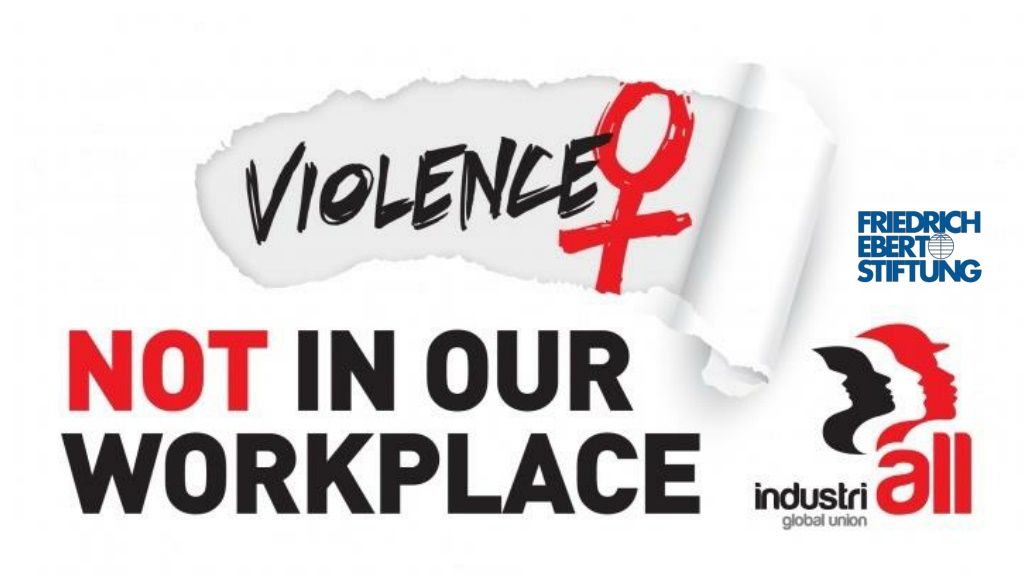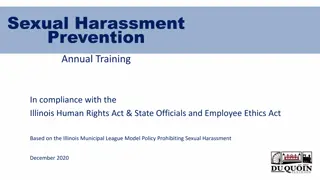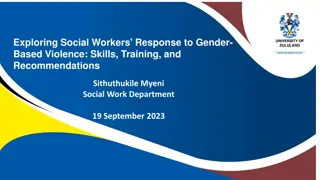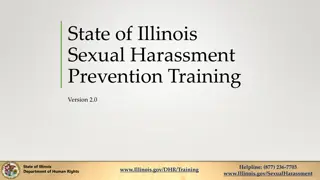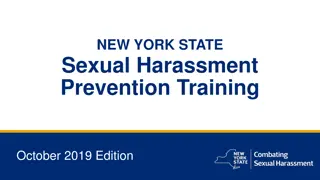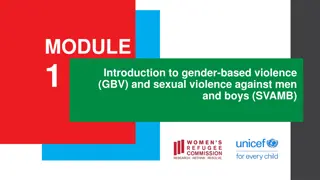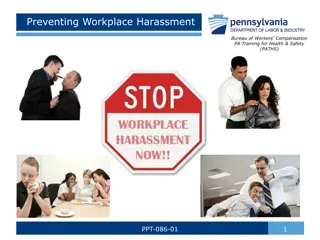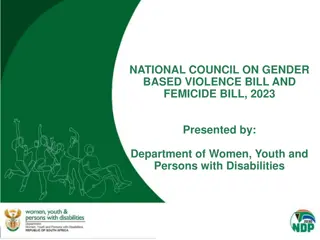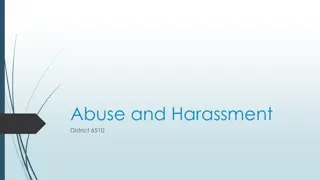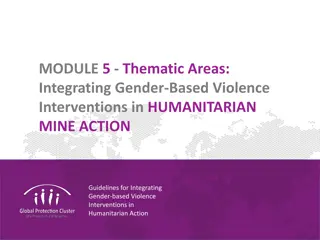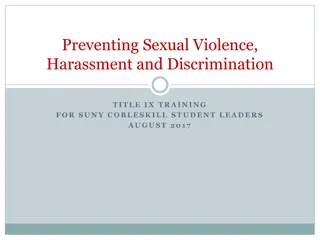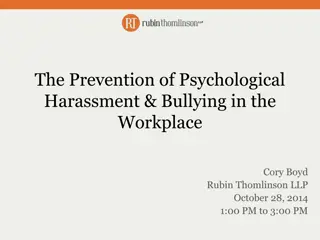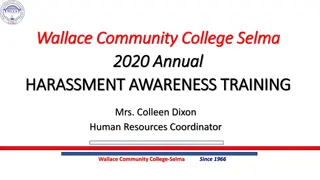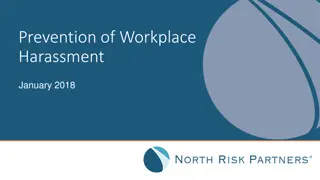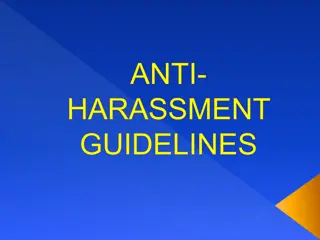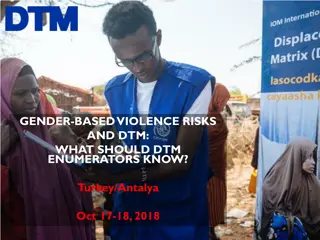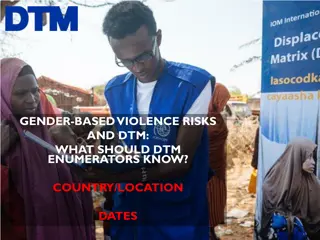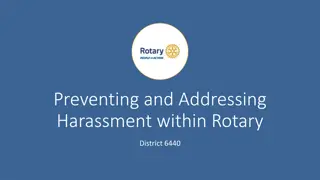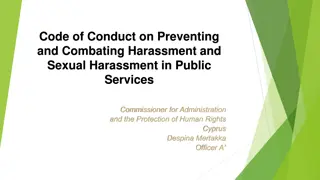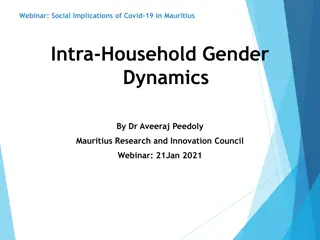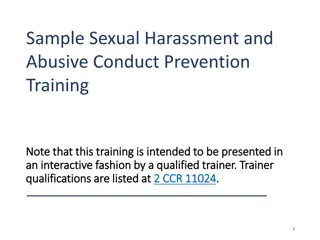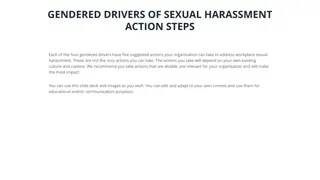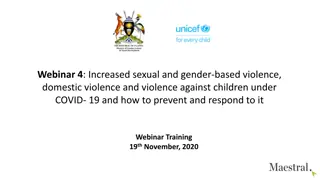IndustriALL Training on Gender-based Violence and Harassment Modules Overview
IndustriALL provides training on gender-based violence and harassment in the workplace through Modules 1-3. Module 1 covers the introduction to gender-based violence definitions and impacts, aiming to address risk factors, understand definitions, and build union capacity to prevent and address the issue. The training structure includes Module 1 on gender-based violence introduction, Module 2 on prevention and risks, and Module 3 on practical workplace strategies. It emphasizes zero tolerance for sexual harassment and encourages group discussions on training experiences and expectations.
Download Presentation

Please find below an Image/Link to download the presentation.
The content on the website is provided AS IS for your information and personal use only. It may not be sold, licensed, or shared on other websites without obtaining consent from the author. Download presentation by click this link. If you encounter any issues during the download, it is possible that the publisher has removed the file from their server.
E N D
Presentation Transcript
IndustriALL IndustriALL Training on gender Training on gender- -based violence and harassment violence and harassment based Power Point slides Training Modules 1-3
IndustriALL Training on gender-based violence and harassment Module 1: Introduction to Module 1: Introduction to, , and definitions of definitions of, , gender gender- -based violence in the world of work violence in the world of work and based
Module 1 1. Introductions and overview 1. Introductions and overview of the training of the training
Module 1 Aims of IndustriALL s GBVH training Aims of IndustriALL s GBVH training 2. Address risk factors, including where workers are disproportionately affected 1. Understand definitions and impact of GBVH 3. Build union capacity / practical strategies to prevent and address the problem in the workplace 4. Use the framework of ILO C190 and R206 in sectoral and workplace negotations 19/09/2024 5
IndustriALL Global Union Policy on Sexual Harassment in Meetings and Activities IndustriALL will not tolerate any form of sexual harassment during activities and meetings Sexual harassment: An unwanted, unwelcome and unasked-for behaviour of a sexual nature If you witness, or are victim of such behaviour, inform immediately the Contact Persons 6
Module 1 Structure of the IndustriALL training Structure of the IndustriALL training Module 1: Introduction to gender-based violence in the world of work Module 2: Prevention and risks of gender- based violence Module 3: Practical strategies in the workplace (4 hours) (4 hours) (4 hours)
Module 1 Group Work 1: Introductions and expectations Group Work 1: Introductions and expectations 1. Introduce yourselves to other group members and share your experiences of: training you have participated in on GBVH actions carried out by your union to end GBVH 2. Let s hear about your expectations: what are your expectations of this training programme? In each group, please nominate someone who can give a short summary to the full group.
Module 1 Let s get started with an ice Let s get started with an ice breaker breaker
Module 1 2. Definitions of gender 2. Definitions of gender- -based violence and harassment violence and harassment based
Module 1 Definitions: Gender Definitions: Gender- -based violence and harassment based violence and harassment ILO Convention 190 (ILO C190) defines violence and harassment as: a range of unacceptable behaviours and practices, or threats thereof, whether a single occurrence or repeated, that aim at, result in, or are likely to result in physical, psychological, sexual or economic harm, and includes gender-based violence and harassment. Gender-based violence and harassment (GBVH) is: violence and harassment directed at persons because of their sex or gender, or affecting persons of a particular sex or gender, disproportionately.
Module 1 ILO ILO C190 defines GBVH as an issue of gender C190 defines GBVH as an issue of gender- - based power relations based power relations Acknowledging that gender-based violence and harassment disproportionately affects women and girls, and recognizing that an inclusive, integrated and gender-responsive approach, which tackles underlying causes and risk factors, including gender stereotypes, multiple and intersecting forms of discrimination, and unequal gender-based power relations, is essential to ending violence and harassment in the world of work. (ILO C190, Preamble)
Module 1 Gender Gender- -based violence and harassment based violence and harassment Gender-based violence and harassment often occur in the context of: - An abuse of power - A promise of reward - A threat of reprisal It disproportionately affects women, but: - it can be experienced by any worker regardless of their gender, gender identity or sexual orientation / LGBTIQ+ people
Module 1 Gender Gender- -based violence & harassment in the based violence & harassment in the world of work world of work Sexual harassment Domestic violence / femicide Economic / financial abuse Sex Stalking discrimination / maternity discrimination Sexual violence / abuse Sextortion 19/09/2024 14
Module 1 Murder Femicide It s not just a joke! The pyramid of sexual harassment and abuse. It starts with sexist jokes. Rape, sexual assault, and physical, emotional & financial abuse Harassment, sexual harassment, threats and verbal abuse Traditional roles and rigid gender-based stereotypes Sexist, homophobic/transphobic jokes. 19/09/2024 15
Module 1 Who is at risk of GBVH? Who is at risk of GBVH? Menand women who do not conform to gender roles / LGBTIQ+ people Whistleblowers / bystanders who intervene or complain may also be at risk of second order sexual harassment (SOSH) Women working in: precarious and insecure employment / unsocial working hours working in isolation/alone male-dominated occupations/sectors Women experiencing: multiple and intersecting forms of discrimination and oppression e.g. women migrant workers, racialised and minoritised women, disabled women 19/09/2024 16
Module 1 Group Work 2: How do you define Group Work 2: How do you define GBVH? GBVH? 19/09/2024 17
Module 1 3. Domestic violence: a 3. Domestic violence: a workplace issue workplace issue 19/09/2024 18
Module 1 Domestic violence: a workplace issue Domestic violence: a workplace issue Domestic violence (sometimes referred to as domestic abuse , intimate partner violence , or family violence ) Can include physical, psychological, sexual and/or economic forms of violence and/or abuse. It can also involve stalking, which may also take place in and around the workplace. Coercive behaviour, includes acts or threatened acts, that is used by a perpetrator to gain power or control over a current or former spouse or intimate partner or family member. 19/09/2024 19
Module 1 Domestic violence: a workplace issue Domestic violence: a workplace issue Physical violence Sexual violence Verbal abuse Coercive control Financial/economic abuse Emotional/psychological control and threats Stalking, virtually or in person Cyber abuse and harassment 19/09/2024 20
Module 1 Domestic violence: a workplace issue Domestic violence: a workplace issue Let s brainstorm on the ways that domestic violence can affect women s work: - getting to work on time / staying in the job - presenteeism / productivity / meeting productivity targets - access to training or career development - financial / economic independence - online or physical safety / security - remote working/telework 19/09/2024 21
Module 1 I can t concentrate at work, I am exhausted and I ve lost my confidence. I m unable to reach my productivity target and do not receive the bonus at the end of the month; the abuse gets worse because my pay is less at the end of the month. I can t get to work because my husband has destroyed my bus pass and hidden my purse. I m worried I will lose my job. The abuse got worse when we were confined at home. It was difficult to compete my work tasks as he was watching what I was doing all the time. He often stopped me participating in team meetings. My manager had some suspicions and called me into the office for a meeting and this was an opportunity to find some support. My husband stops me from attending the company training course or applying for promotion, he says I should leave my job and devote my time to him as this is a sign of real love. I have been stalked by my ex-partner at work, first by email and telephone, and later in the car park where I park the car. My trade union representative helped me to get the help I needed. 22 I couldn t leave as I had no money, he controlled all of my finances and I no longer have access to any money. Where would I go with no money? 19/09/2024
Module 1 Domestic violence: Domestic violence: ILO Convention 190 ILO Convention 190 Noting that domestic violence can affect employment, productivity and health and safety, and that governments, employers and workers organizations and labour market institutions can help, as part of other measures, to recognize, respond to and address the impacts of domestic violence.. (Preamble) 19/09/2024 The Convention calls on governments to recognize the effects of domestic violence and, so far as practicable, mitigate its impact in the world of work . (Article 10f) 23
Module 1 Interlinked forms of power and Interlinked forms of power and control of women in relation to control of women in relation to domestic violence and its effects domestic violence and its effects on the world of work. on the world of work.
Module 1 4 4. GBVH: a trade union issue . GBVH: a trade union issue 19/09/2024 25
Module 1 Group Work 3: Why is GBVH Group Work 3: Why is GBVH a trade union issue? a trade union issue? 19/09/2024 26
Module 1 6. Introduction to the distance 6. Introduction to the distance learning activity and feedback on learning activity and feedback on Module 1 Module 1 19/09/2024 27
Module 1 Introduction to Distance Introduction to Distance Learning Activity 1 Learning Activity 1 19/09/2024 28
Module 1 Feedback and evaluation Feedback and evaluation Finally, we would be interested in some brief feedback about Module 1. How did you find Module 1? Can you see the relevance of what you have learnt for your workplace or sector? Is there anything you would like to add that would be relevant for the next Module? Any other comments? 19/09/2024 29
Module 2 IndustriALL Training on Gender-based violence and harassment Module 2: Prevention of GBVH Module 2: Prevention of GBVH 19/09/2024 30
Module 2 1. Introduction to Module 2 1. Introduction to Module 2 and to GBVH prevention and to GBVH prevention 19/09/2024 31
Module 2 Introduction to Module 2: Risks of GBVH Introduction to Module 2: Risks of GBVH Welcome back to Module 2! Introductions and check-in The main focus of Module 2 is on how to identify and address risks of gender-based violence and harassment 19/09/2024 32
Module 2 Reporting back from the distance learning Reporting back from the distance learning activity activity Let s hear from participants about what you found out in your distance learning assignment in your workplace: how easy was it to find this information? are you surprised at what you have learnt? what are the main gaps that need to be addressed? 19/09/2024 33
Module 2 Why is prevention a good entry point? Why is prevention a good entry point? Prevention is a good entry point for discussing sensitive issues related to GBVH A gender-responsive approach challenges traditional approaches to occupational health and safety (OSH) Do prevention programmes, including risk assessments, address risks of violence and harassment in a gender-responsive way? For example: gender inequalities in the workplace, such as working in a male-dominated working environment cultural and social norms that increase the risk of violence and harassment against women risks associated with domestic violence when it impacts the workplace 19/09/2024 34
Module 2 5 steps in conducting 5 steps in conducting a a workplace risk assessment assessment workplace risk Identify the risk Assess the risk Mitigate the risk Monitor Review 19/09/2024 35
Module 2 Group work 1: Mapping the Group work 1: Mapping the worksite to identify risks of worksite to identify risks of sexual harassment (optional) sexual harassment (optional) 19/09/2024 36
Module 2 2. Introduction to ILO measures to 2. Introduction to ILO measures to prevent GBVH prevent GBVH 19/09/2024 37
Module 2 ILO ILO C C190: a focus on prevention 190: a focus on prevention Acknowledging that gender-based violence and harassment disproportionately affects women and girls, and recognizing that an inclusive, integrated and gender-responsive approach, which tackles underlying causes and risk factors, including gender stereotypes, multiple and intersecting forms of discrimination, and unequal gender-based power relations, is essential to ending violence and harassment in the world of work. (ILO C190, Preamble) ILO C190 calls for an inclusive, integrated and gender-responsive approach for the prevention and elimination of violence and harassment in the world of work (Article 4(2)) and the adoption of a comprehensive strategy to prevent and address violence and harassment (Article 42c) 19/09/2024 38
Module 2 Duties on employers ( Duties on employers (ILO ILO C190, Art.9) C190, Art.9) Obligations on governments to prevent violence and harassment include positive duties on employers to protect workers, to: a) adopt and implement, in consultation with workers and their representatives, a workplace policy on violence and harassment; b) take into account violence and harassment and associated psychosocial risks in the management of occupational safety and health; c) identify hazards and assess the risks of violence and harassment, with the participation of workers and their representatives, and take measures to prevent and control them; and d) provide workers and other concerned persons with information and training, in accessible formats as appropriate, on the identified hazards and risks of violence and harassment and the associated prevention and protection measures. 19/09/2024 39
Module 2 Where might risks occur? Where might risks occur? ILO C190, Article 3, definition of the world of work: workplaces, including public and private spaces that are a place of work places where the worker is paid, takes a rest break or a meal, or uses sanitary, washing and changing facilities work-related trips, travel, training, events or social activities work-related communications, including those enabled by information and communication technologies employer-provided accommodation commuting to and from work 19/09/2024 40
Module 2 Risk assessments (R206) Risk assessments (R206) The Recommendation states that account should be taken of risk factors that increase the likelihood of violence and harassment, including psychosocial risks and hazards, through a gender-responsive approach, that: a) arise from working conditions and arrangements, work organization and human resource management, as appropriate; b) involve third parties such as clients, customers, service providers, users, patients and members of the public; and c) arise from discrimination, abuse of power relations, and gender, cultural and social norms that support violence and harassment. 19/09/2024 41
Module 2 What are psychosocial risks? What are psychosocial risks? Psychosocial risks at work are linked to the work environment and human factors: potential to cause workplace stress and violence and harassment. in the context of (organisation of work and labour relations) and the content of (working conditions, job contents, etc.) result in negative psychological, physical and social outcomes such as work-related stress, burnout, ill-health, depression, violence and harassment. Examples: Excessive workloads Conflicting demands Lack of involvement in making decisions that affect the worker Lack of influence over the way the job is done Poorly managed organisational change, job insecurity Ineffective communication, lack of support from management or colleagues 19/09/2024 42
Module 2 3. Identifying and addressing 3. Identifying and addressing risks of GBVH risks of GBVH 19/09/2024 43
Module 2 Group Work 2: Case studies: Group Work 2: Case studies: identifying risks of and solutions identifying risks of and solutions to GBVH to GBVH Aim: to identify situations / risks in the world of work where GBVH may occur Case study 1: Women garment workers sewing dresses and shirts for a large brand Case study 2: Woman working as an assembly worker in an electronics factory producing printers for global markets Case study 3: Woman working as a technician in a large coal mine on a night shift with different sites Case study 4: Woman in a front office reception job in a large manufacturing company Case study 5: Participants in a union training course Case study 6: Gay man working in a company canteen 19/09/2024 44
Module 2 Garment sector: Summary of findings from Garment sector: Summary of findings from IndustriALL s research IndustriALL s research Risks: Production pressures / verbal abuse Fear of reporting, ineffective complaints procedures Culture of impunity - sexual favours e.g. in return for a job Predominantly female workforce, women work in precarious jobs Low level of collective bargaining Example of how to mitigate the risk: One union trained its workplace representatives to spot the signs of sexual harassment. When they observed inappropriate behaviour they reported it to management. 19/09/2024 45
Module 2 Mining sector: Summary of findings from Mining sector: Summary of findings from IndustriALL s research IndustriALL s research Risks: Male dominated workforce Masculinized culture/working environment Work in isolation / night work Workplace policies are not used or trusted Inappropriate PPE Domestic violence impacts on women s participation in work / safety at work Example of how to mitigate the risk: One trade union held a consultation with women workers to find out about the risks they faced at the mine. Women raised many concerns, including when they worked at night, problems with ill-fitting PPE, access to toilets, sexist jokes; and some women spoke of risks from an ex-partner in the workplace. The union took these concerns to management and the workplace safety committee. 19/09/2024 46
Module 2 ICT Electronics Sector: Summary of findings ICT Electronics Sector: Summary of findings from IndustriALL s research from IndustriALL s research Risks: Precarious contracts Low awareness of GBVH Workplace policies & reporting systems are not trusted Culture of silence, victim blaming and impunity around GBVH Limited social dialogue Limited data showing evidence of GBVH Example of how to mitigate the risk: One union established a confidential help line to enable any worker to report cases of sexual harassment directly to the union. This helped the union to identify where there were risks of sexual harassment and to suggest ways to mitigate them to management. 19/09/2024 47
Module 2 4. Prevention though gender 4. Prevention though gender- - responsive risk assessment responsive risk assessment 19/09/2024 48
Module 2 What is gender What is gender- -responsive risk assessment? responsive risk assessment? Risk assessment is a core part of risk management and an important starting point for prevention. Integrate prevention of GBVH into existing risk assessment frameworks or Carry out a stand-alone risk assessment on GBVH or Address urgent risks that have been identified e.g. when there is a risk of domestic violence spilling over into the workplace, and draw up a tailored safety plan 19/09/2024 49
Module 2 Mitigating risks and prevention plans Mitigating risks and prevention plans Assess gaps in existing mitigation measures and prevention plans in addressing violence and harassment, including gender-based violence and harassment. If there are gaps, make recommendations to address these risks in future prevention plans, e.g. Safety measures to ensure that women do not work alone, particularly at night. Alarm systems and security to assist isolated workers when they are in difficult situations; safety planning, incident response training and raising awareness among workers, including gender-responsive approaches. Better protection systems for women working remotely/tele-working. Consultations with workers and ensuring that women have a voice in raising their concerns. Effective and trusted complaints systems in place. 19/09/2024 50
